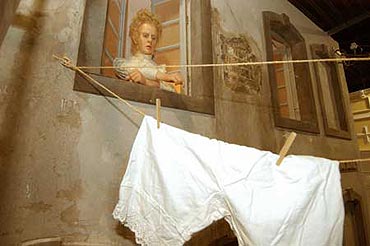Schrift: größer/kleiner
Inhaltsverzeichnis
Sie sind hier: WirRheinländer > english version > The Exhibition > Scenes > Residential
Residential / red-light district 1880

Overcrowded, extortionate, ugly tenements in desolate streets. Cramped flats, sparsely furnished, inadequate hygienic conditions. Unbalanced nutrition, unreasonably long working hours, low wages, abysmal basic conditions. The workplace was draughty, dark and dirty. The streets were not safe. Contraception was unknown.
The impoverishment of the proletariat continued into the 1870's. Slums grew in the fast growing towns. People became brutalized. There were few professions and areas of work open to women. From a lack of alternatives and from social necessity many were obliged to go into prostitution, in order to earn a living.
As the state made no extensive social provisions for a long time, companies created their own social facilities, e.g. pension funds.
Not without their own self-interest, as Werner von Siemens explained in 1872:
"Increasingly it is regarded as the duty of employers… to look after the workers whose labour they exploit.. This shows that the entrepreneurs are reacting to the increasing pressure of society, which is pushing for the welfare of workers due to the growing recognition of socialist ideas. It is also highly important to create a permanent workforce.. If they are steadfastly convinced that those who stay with us will be taken care of in old age, including their families, then they will be tied to the business."
(Zitiert in: Dietrich, Carola und Annika Burchard: Die Soziale Frage im 19. Jahrhundert, Geschi.de 2002, S. 14)


